Welcome to the 10th edition of First Nations News & Views. This weekly series is one element in the “Invisible Indians” project put together by Meteor Blades and me, with assistance from the Native American Netroots Group. Last week’s edition is here. In this edition you will find a story about First Nations pipeline protests in Vancouver, a look at the years 603 and 1916 in American Indian history, three news briefs and a big collection of linkable bulleted briefs. Click on any of the headlines below to take you directly to that section of News & Views or to any of our earlier editions.
By navajo
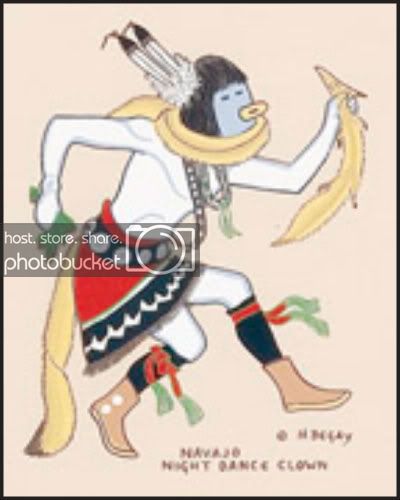 Navajo Night Dance Clown
Navajo Night Dance ClownToday we feature medicine clowns in honor of April Fools’ Day. Many American Indian cultures have medicine people whose focus is emotional and spiritual healing though humor and parody. The English term clown is translated in various native languages to refer to members of a community who are considered tricksters, riddlers and jokers but who are also healers, mediators, oracles, counselors, storytellers and teachers. The Hopi Hyoka is the best-known example. Some tribes traditionally viewed medicine clowns as shape-shifters and changelings. As with other aspects of indigenous religions, the clowns were suppressed and demonized by invading European religious leaders who considered them a threat to their conversion-to-Christianity crusade. Eventually, Indian religion was banned entirely. But the custom of the clown was kept alive through oral history. An example of their practice is conflict resolution. The medicine clown would reenact the conflict using humor and satire. Once everyone was laughing the conflict could be resolved because of the mood. The Wampanoag Ahanaeenun are an example of contemporary medicine clowns who keep their traditions alive using technology and the written word to maintain the spiritual and emotional well-being of their community in a modern society.
By navajo and Meteor Blades
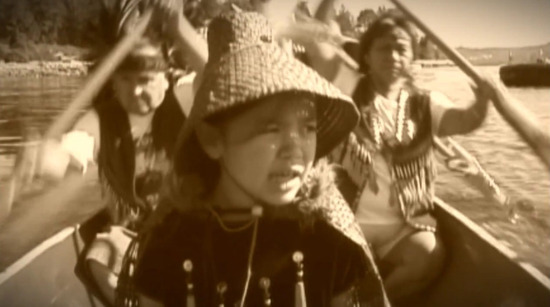
Just days after the 23rd anniversary of the infamous Exxon Valdez spill in Alaska, more than 2000 people came out in support of a March 26 rally in Vancouver organized by First Nations people and environmental groups to protest the oil tanker traffic along British Columbia’s coastline and proposed pipeline expansion throughout Canada.
Rain is an eternal presence in the region and did not stop the large crowd from gathering in front of the Vancouver Art Gallery. Many First Nations people turned out in full traditional regalia, perfectly designed to deal with rain. Among the many speakers was famed environmental advocate and climate-change activist Bill McKibben:
Along with protecting this most beautiful coastline, and along with protecting all the people and other creatures that have been here for so long, you also have the great honor and the great burden of having to help protect the rest of the planet.
What they want is for British Columbia to be a kind of carbon portal, a kind of carbon gateway for oil and coal … and we just can’t let that happen. That oil has got to stay in the ground.
McKibben’s reference is to the tar sands oil of Alberta, much in the news in the United States because of opposition to the 1661-mile Keystone XL that builder TransCanada has proposed to deliver the hydrocarbon in those sands, bitumen, in a slurry from Canada to the Texas Gulf coast where most of it will be exported. McKibben and hundreds of other pipeline foes, including many American Indians, were arrested for protests around the White House last summer.
The Vancouver protesters object to the proposed $5.5 billion (Canadian) Northern Gateway pipeline to be built by Calgary-based Enbridge. It would carry slurry bitumen the 731 miles from Bruderheim, Alta., to Kitimat, British Columbia. The Despite significant financial and other benefits being offered First Nations people, some 60 percent still oppose it on environmental, social and cultural grounds.
Edwin Newman (Heiltsuk First Nation) one of the main organizers of this event, said, “We are trying to protect a way of life, a way of life that we’ve enjoyed as Heiltsuk people and as coastal people since time immemorial. We’re pleading with our coastal neighbours to stand with us to fight this issue.”
The Heiltsuk, which, with two neighboring First Nations people once populated a large portion of the central coast of British Columbia, are now based at Bella Bella on Campbell Island, 250 miles south-southwest of Kitimat and vulnerable to tanker spills. A Heiltsuk member read a statement in opposition to allowing pipelines and oil tankers passage through their territory.
The most moving speaker, who actually sang her protest, was Ta’Kaiya Blaney (Sliammon First Nation), an 11-year-old actress, singer and songwriter who performed her song “Shallow Waters” (lyrics) for the crowd. Released in early 2011, the song warns that an oil spill along the northwest coast could end all hope of maintaining traditions for coastal First Nations people. A spill would devastate marine life and coastal habitat. The lyrics and melody are hauntingly beautiful.
from Sasha Schriber
The studio version is here with amazing images and Blaney in her traditional cedar bark regalia. The documentation is very well done. It’s had 87,333 views. Her crying voice pleads to our emotions to listen, please listen, and do something.
The crowd, led by the First Nations, then marched to Enbridge Northern Gateway offices and surrounded the building, trapping the people inside for a time.
The demonstration ended peacefully.

Pakal the Great, King of Palenque, Born in 603
On March 23, 603, the most famous Mayan king, K’inich Janahb’ Pakal, was born. (If you prefer the Mesoamerican Long Count calendar to mark important birthdays, it was 9.8.9.13.0, that is: 9 b’ak’tun, 8 k’atun, 9 tun, 13 winal, 0 kin from the 3114 BCE creation of the world according to the Maya. Yes, that’s a zero, the Maya being among the first to use it.) He was born in Otolam or Lakam Ha (Big Water) in the lowlands of what is now Chiapas state in southern Mexico. The Spanish conquistadors named the place Palenque, already a centuries-old ruin by the time they first visited in the 1500s.
The word “Pakal” means “shield” in the Chol Maya dialect. The king is familiarly known as Pakal the Great. He took the throne from his mother Sak K’uk’ at age 12 and ruled for 68 years. It was in his time that great architecture was built in Palenque, a response to attacks and destruction from another city state. Pakal’s tomb, in the Temple of Inscriptions (named for the extensive text on its walls), was for decades after its 1948-52 excavation by Alberto Ruz Lhuillier considered the richest and best preserved archeological find of the ancient Americas. It took Ruz four years to dig through the floor of the temple, carefully clear the rubble and discover the elaborately carved sarcophagus. Ruz wrote:
Out of the dim shadows emerged a vision from a fairy tale, a fantastic, ethereal sight from another world. It seemed a huge magic grotto carved out of ice, the walls sparkling and glistening like snow crystals. Delicate festoons of stalactites hung like tassels of a curtain, and the stalagmites on the floor looked like drippings from a great candle. The impression, in fact, was that of an abandoned chapel. Across the walls marched stucco figures in low relief. Then my eyes sought the floor. This was almost entirely filled with a great carved stone slab, in perfect condition.
Under that slab, Ruz ultimately found, was a skeleton, the skull covered with a jade mask. The whole was surrounded by stucco and stone reliefs connecting the occupant with Maya mythology and the afterlife. The inscriptions stated this was indeed K’inich Janahb’ Pakal, but there were scientific concerns. After years of dispute over the age of the man whose bones these were, most scholars agree that the remains really are Pakal’s.
Ishi, the Last of His Tribe, Dies in 1916
By Meteor Blades
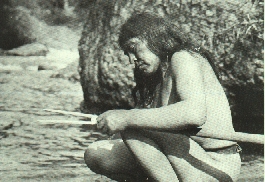
On March 25, 1916, a Yahi Indian of the Yana people named Ishi died of tuberculosis in his quarters at the University of California’s anthropology museum in San Francisco. He was about 55 years old. Thanks to national fascination with him almost from the moment he stepped out of the woods near Oroville, he is possibly the most famous California Indian who ever lived. Except for the final five years of his life, he lived completely outside the white world.
During those five years, he was intensively studied. He became friends and a hunting companion of some of those who studied him, taught them the intricacies of his dialect and aspects of his culture, including how to knapp stone arrowheads the way he had been taught. In the latter case, his techniques are still used by many modern flint-knappers.
He was born about 1862, a time of tremendous pressure from whites on the Indians of northern California. The influx of the gold rush was over, but the flood of immigrants to the state never stopped. Mining and other activities wreaked ecological havoc everywhere they turned, killing off food sources for the Indians and driving down their population numbers by squeezing their habitant and by the California genocide. Ishi was a survivor of that slaughter.
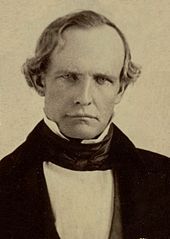
The first governor of California, Peter H. Burnett, didn’t start that genocide, but he added to it. In January 1851, he said: “That a war of extermination will continue to be waged between the races, until the Indian race becomes extinct, must be expected. While we cannot anticipate this result but with painful regret, the inevitable destiny of the race is beyond the power or wisdom of man to avert.” That “painful regret” didn’t stop future governors from supporting volunteer militias to hunt and kill Indians. Between 1851 and 1859, the state spent more than $1.3 million for this purpose. The federal government reimbursed California for some of this spending. In addition, towns offered scalp bounties, as much as $5 each in some cases.
Groups like Humboldt Home Guard, the Eel River Minutemen and the Placer Blades terrorized and murdered local Indians. The 19th century historian Hubert Howe Bancroft wrote: “The California valley cannot grace her annals with a single Indian war bordering on respectability. It can, however, boast a hundred or two of as brutal butchering, on the part of our honest miners and brave pioneers, as any area of equal extent in our republic.”
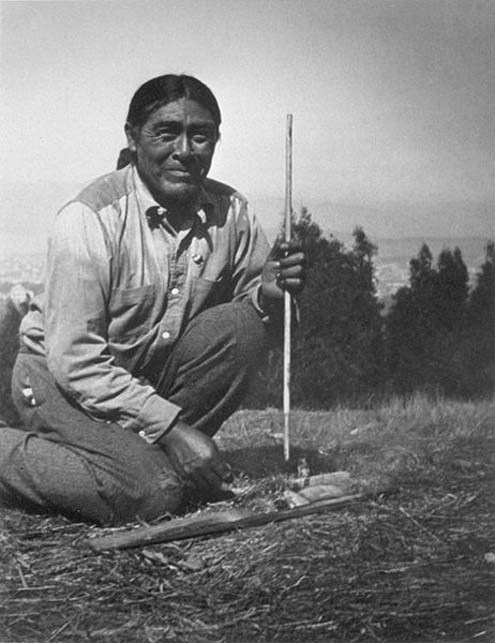
At statehood in 1850, the Indian population of California was estimated to be 150,000, about half what it is thought to have been when the Spanish arrived. Thanks to the government-funded extermination policy, by 1900 only 16,000 remained. Among them were Ishi, his mother and his sister, survivors of the Three Knolls Massacre of 1865. That is when an impromptu militia of white settlers had killed some 40 Yahi on Mill Creek, a tributary of the Sacramento River near Mt. Lassen in today’s Tehama County. The survivors, including 3-year-old Ishi, had fled.
Half of them were killed in 1867 or ’68 by another ad hoc militia. Its leader, Norman Kingsley, later said that during the slaughter, he had exchanged his .56 caliber Spencer rifle for a .38 Smith & Wesson revolver because the rifle “tore them up so bad,” particularly the babies. The few remaining Yahi fled into the wilderness where they effectively hid out for the next 40 years.
In 1908, a survey team ran across Ishi’s camp. He fled with his sister and another man, but his mother was too frail to run. The surveyors looted the camp, taking everything of value. Soon afterward, the rest of Ishi’s tiny band died. For the next three years, he lived alone. But in 1911, starving, he stole into a slaughterhouse where he was caught by the butchers and briefly jailed.
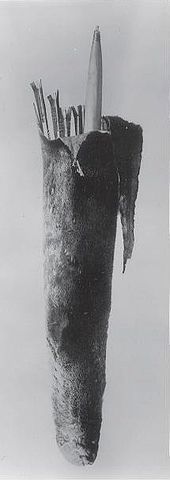
It was at that point that he came to the attention of anthropologists Thomas Talbot Waterman and Alfred Kroeber, who would make the Indian their research assistant and life’s work. When the ambitious Kroeber first heard about Ishi’s appearance, he wrote to linguist Edward Sapir: “Have totally wild Indian at the museum. Do you want to come and work him up?”
Ishi spent a good deal of time teaching the linguists and anthropologists what he knew. But he was also quite involved in the community. He dated, he played with local children. One of the most difficult adjustments for him was crowds. Before he went looking for a meal in that slaughterhouse, he had never seen more than perhaps 50 people all in one place.
After five years living in the white world that he had previously avoided all his life, he died of tuberculosis. In his culture, keeping the body intact for burial was important, but the doctors performed an autopsy, removed his brain and cremated the ashes. Those were buried at Mt. Olivet Cemetery in San Francisco, but the brain wasn’t interred with them for another 89 years.
Much has been written about Ishi, the most famous being the book published on the 50th anniversary of his emergence from the wild, Ishi in Two Worlds, written by Alfred Kroeber’s anthropologist wife Theodora. In 2003, anthropologists Clifton and Karl Kroeber, sons of Theodora and Alfred, edited Ishi in Three Centuries, a scholarly book on the subject that included essays by American Indians. In 2004, anthropologist Orin Starn wrote Ishi’s Brain: In Search of America’s Last “Wild” Indian There was a television film in 1978, a mediocre biopic called Ishi: The Last of His Kind.
In 1996, based mostly on the style of arrowheads that Ishi knapped, research archaeologist Steven Shackley concluded that Ishi likely wasn’t the last pure Yahi, but a mixed blood whose parents, like other California Indians may have been forced by white encroachment and slaughter into tribal mergers with their enemies. Proof of that theory likely will never be known. Today, there are no known members of the Yana, the larger group of whom the Yahi were a part.

Montana Judge Orders Stop to Further Wild Bison Transfers
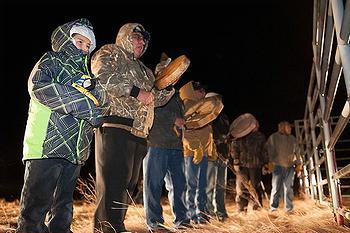
Fort Peck Indian Reservation, March 21, 2012.
Montana Gov. Brian Schweitzer, wildlife conservation advocates and members of the Assinibone and Sioux (Nakota) tribes celebrated the arrival of 62 genetically pure, wild Yellowstone bison to the Fort Peck Reservation on March 21. But it will be the last such move for a while. The next day a Montana judge turned objections of white ranchers and property rights groups into a temporary restraining order on such transfers. A hearing will be held April 11 in Chinook. Thus continues a fight that in various forms is a century-and-a-half old.
Unaffected are the four bison already on their way from Yellowstone when Judge John McKeon issued his order. But the transfer of half the herd of 62 to the Fort Belknap Reservation (Assiniboine-A’aninin-Gros Ventre) and a planned transfer from the herd of billionaire Ted Turner are on hold. That puts a major hurdle in the path of a long-term wild bison restoration program that Gov. Schweitzer has enthusiastically endorsed.
Opponents of the transfer who filed the lawsuit that prompted McKeon’s action want the relocation program stopped permanently. They argue that wild bison will hurt their livelihood by spreading disease to cattle herds, eating hay meant for those cattle and damaging fences meant to keep cattle penned in. Tribal leadership at Fort Peck and Fort Belknap have pledged to keep the bison in fenced pastures for several years and monitor them for disease. The message ranchers want to deliver is as clear as it was in the 1870s when bison were being slaughtered in their millions and Indians were being herded into their own pens: This land is our land, not your land.
The 62 bison shipped to Fort Peck were moved without prior public notice and during a snowstorm-a maneuver by the Schweitzer administration and tribes that was meant to get the bison to Fort Peck ahead of a possible court ruling such as the one handed down [March 22].
Opponents of the relocation complained the tactic violated requirements under state law that the transfers be part of an open and transparent process.
Cory Swanson, an attorney for the plaintiffs in the lawsuit, said Thursday’s ruling was a huge victory […]
“There’s no more stealthy movement of bison anywhere. No more secret agreements that are not fully part of the process,” Swanson said. “The trust factor is really low here and the judge recognized that.”
The 62 Yellowstone bison spent five years in quarantine to ensure that they were free of brucellosis, a bacterial disease that can infect sheep, cattle, dogs and humans. Some Indian advocates of restoring wild bison to a portion of their former range consider the quarantine not only unnecessary but part of a long-standing pattern.
“Quarantine is an insulting government program force-fed to First Nations as the only way to reconnect with buffalo,” blogs Peet on the Buffalo Field Campaign website. “It is damaging to wild bison and the Tribes that would see them home again. Is that all we can do is abuse wildlife, create livestock situations and call it wildlife restoration? We can certainly do better in our efforts at ‘wildlife restoration’ than to abuse and treat members of America’s only continuously wild population of buffalo like livestock. Quarantine is no more than a fear-based response to unfounded livestock industry complaints that are nothing but efforts to protect a subsidized lifestyle.”
The Buffalo Field Campaign, which works to stop Yellowstone’s 3000 wild bison from slaughter and harassment asserts that these 62 animals were the only survivors of a process of confinement that denied them their natural instincts and caused injuries and deaths from stress and human handling. Several females, the BFC said, were overfed during winter and died while trying to deliver their calves in spring. Other young mothers abandoned their calves. Some bison were gored or crushed to death against the corral pens and many were slaughtered.
The transferred bison aren’t the first at Fort Peck and Fort Belknap. The tribes have worked assiduously since the 1970s to restore the animals. About 700 already graze at Fort Belknap and another 200 can be found at Turtle Mound Buffalo Ranch on the Fort Peck reservation.
Theirs is part of what Jamie Rappaport Clark, president of Defenders of Wildlife and a former director of the U.S. Fish and Wildlife Service, says is “a much broader effort to restore Yellowstone bison to more places across the entire region and revitalize our prairie ecosystems.”
She was in the small crowd at Fort Peck to welcome the animals:
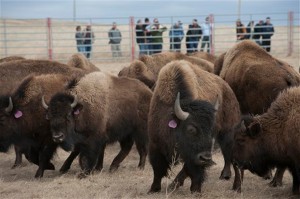
“The return of genetically pure, wild bison to tribal lands in eastern Montana has been a long time coming, and it’s great to see it finally happening. […] Native Americans have had a special relationship with bison for thousands of years,” said Clark. “The tribes at Fort Peck and Fort Belknap have generously offered to take these wild bison to restore new herds of genetically pure bison, which only adds to the cultural significance of this homecoming. We would like to thank the tribes for making this dream come true, and we’re honored to have been able to play a part in making it happen.”
Her organization has already put up more than $84,000 for bison restoration on the two reservations. It will also help pay for fencing and buying contiguous grazing allotments.
While there are today perhaps 500,000 fenced bison in commercial herds, most of them are genetically intermixed with cattle breeds and sold for meat domestically and abroad. An estimated total of 20,000 genetically pure bison live, but none but those in Yellowstone are completely free roaming.
The connection is direct between the 62 transferred bison and the millions that once roamed the Great Plains until a government-funded extermination policy directed at domesticating and confining the Plains tribes nearly brought the species to extinction. As Ojibwa tells the story:
One hundred-forty years ago, Walking Coyote (Pend d’Oreille) of the Flathead Reservation had, as a consequence of killing his wife, fled to live among the Blackfoot. He became homesick and some Blackfoot told him it might help if he were to capture a few bison and take them back to the Flathead Reservation “as a kind of peace offering.” Together with his Blackfoot companions, he caught some stray, motherless calves and returned with them to his reservation. Twelve years later Charles Allard and Michael Pablo started their own herd with bison bought from Walking Coyote. In 1902, 21 bison from the Allard-Pablo herd were bought by Yellowstone National Park.
“We recognize the bison is a symbol of our strength and unity, and that as we bring our herds back to health, we will also bring our people back to health.”
– Fred DuBray, former president Inter Tribal Buffalo Council, 2005
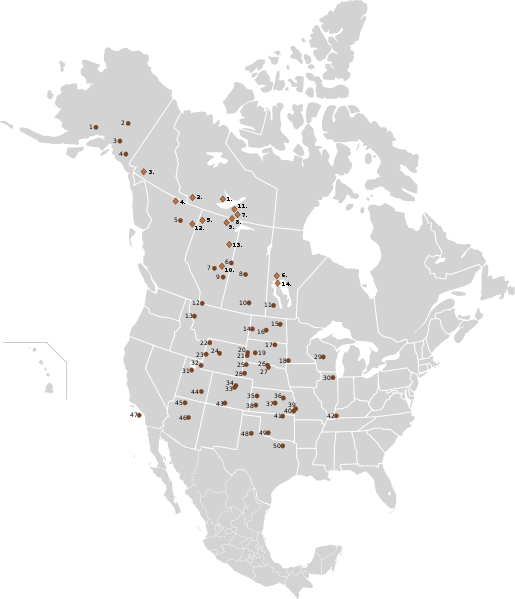

“Greeks” Apologize for Hosting a “Cowboys and Indians”-Themed party at DU
By navajo and Meteor Blades
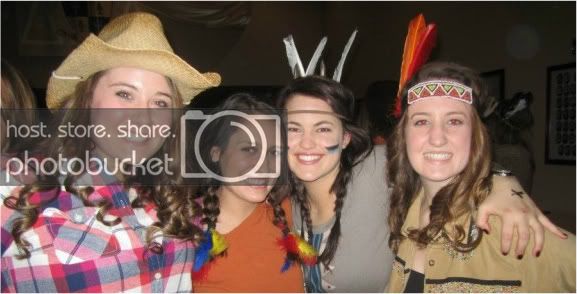
Two University of Denver “Greek” chapters, Lambda Chi Alpha fraternity and Delta Delta Delta sorority hosted a “Cowboys and Indians” party Feb. 25. Photos of the event soon hit Facebook and made their way to the inboxes of members of the DU Native Student Alliance. They were not pleased. Soon their displeasure was felt all the way in the office of DU Chancellor Robert Coombe. He ultimately decried the party and after a months of talking, members of the two Greek houses made public apologies. But did those apologies really mean anything? Only a single representative from each Greek house showed up to read the apologies.
Said Viki Eagle, (Sicangu Lakota Nation) co-chair of the NSA, “This proves to me that our society and our fellow students still view us as nonexistent, [our peers] depicted us as mascots or a Halloween costume.”
Simon Moya-Smith (Oglala Lakota), the DU graduate student adviser to the NSA, said the party was offensive “because it dehumanizes and objectifies American Indians. People think our regalia are costumes to play around in, but they are not costumes. They are very spiritual and, if you want to use the western term, holy garb that would be reserved for elders of title.”
From Indian Country Today:
[S]ome American Indian students feel that the theme party is just another blistering offense to add to DU’s lengthy pattern of racial insensitivity toward its American Indian community.
Amanda Williams, 18, a member of the Navajo and San Carlos Apache tribes, said that last year DU had planned to title their homecoming parade “How the West Was Won” until the Native Student Alliance petitioned and protested against the name.
And according to Williams, on the night of the Cowboys and Indians party, a classmate and dorm neighbor had knocked at her door and asked her if she had “anything Indian” he could wear to the party.
Determined not to let the matter pass, the NSA requested a formal apology. When they finally got a promise in the matter, they sent a letter to supporters:
Last month, two University of Denver Greek Life organizations hosted a piercingly offensive Cowboys and Indians theme party where students donned phony headdresses, face paint, loincloths, and all manner of stereotypical viciousness.
[…]
After weeks of correspondence with the director of student activities at DU, the school and the Greek Life organizations – Lambda Chi Alpha and Delta Delta Delta – have agreed to publicly apologize to the members of the Native Student Alliance.
Yet we, the members of NSA, believe that they should not only apologize to us, but to the American Indian community at large for their arrogance and ignorance.
Megan Pendly Pickett, assistant director of campus activities, who acted as a liaison between the NSA and the Greek chapters, revealed in an email to NSA that “the leadership of both Greek communities are baffled as to why an apology is warranted at all. They don’t believe they’ve done anything wrong.” That, of course, calls into question just how sincere the “Greeks” were when they agreed under pressure from students and the administration to make the apology. Native students experience that kind of racial insensitivity on a daily basis. Not at all unlike the attitude of people who who shudder at a sports team called the “Niggers,” but find nothing wrong with “Redskins.”

The public apology was scheduled for late afternoon on March 25 at a spot on the campus green where NSA had erected a tipi. A crowd of more than 100 students, faculty and community members gathered for the event.
“We understand our event was insensitive and hurtful to other members of the DU community,” said [Ross] Larson. “I’m here to make sure we can right our wrongs.” [Larson also said that the party was held “out of ignorance,” and not “racism.”]
Delta Delta Delta representative Molly Gasch said during her apology that the party will “be the last of its kind for our groups.”
“We understand that we have detrimentally affected more than just ourselves by failing to act as the community leaders that we strive to be,” she said, reading from a document. “Both of our organizations will be using this as an opportunity to improve our fraternity and sorority member education programs by increasing awareness and sensitivity of minority groups on campus.”
In an email to the DU community, Chancellor Coomb wrote:
Whether or not anyone meant to be disrespectful or hurtful, their actions did inflict painful wounds. We must all come to understand how our actions affect others, and how cartoonish depictions not only push us apart, but also reflect our limited understanding of one another.
Members of the Native Student Alliance, the Campus Activities office, the Center for Multicultural Excellence, and the involved fraternity and sorority have already embarked on a learning and healing process, meeting several times since the incident to talk, and more importantly, to listen.
Sounds an awful lot like what used to be called “palaver.” While the public apology could be seen as a step in the right direction, the failure of the Greek community to show up indicates that a large group of party-goers still doesn’t understand or care about the issue. From experience, American Indians know what the whisperers are likely still saying: “What’s the big deal?”

Caught with Illegal Animal Parts, Welsh “Apache” Claims Native Heritage
By Meteor Blades
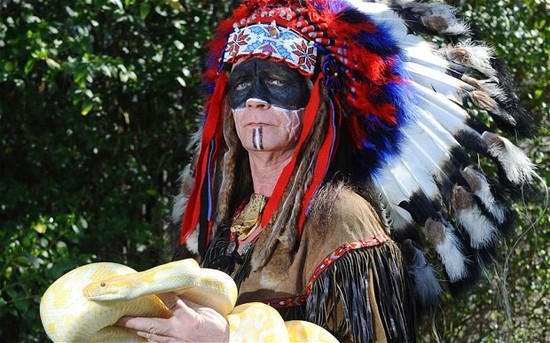
The reporters have had a fun time with Mangas Coloradas. The 60-year-old Welshman claims to be Apache. Or at least he has since a divorce 20 years ago when he took the name of a famous Eastern Chiricahua leader and began living what he calls the Apache lifestyle out of what the Telegraph smirkily notes is “his three-bedroom detached house in the Townhill suburb of Swansea.” Dasoda-hae-the real Mangas Coloradas (“Red Sleeves,” in Spanish, a translation of his Apache nickname: Kan-da-zis Tlishishen)-would surely be smirking, too. But the failure to go beyond smirking reinforces stereotypes.
The Welshman traveled to the United States in 1997 and tried to live on a reservation, but he says the government would not let him. He lived in Spain in a tipi for a while, too. He keeps snakes as pets and claims to have cured thousands of people of their fear of them. He makes tomahawks and bows and arrows. He also says he loves animals in general. But what got him notice in the newspapers and on-line, starting in January in the South Wales Evening Post was the fact he was arrested with badger paws and bird parts in his house, a violation of the 1992 Protection of Badgers Act and the 1981 Wildlife and Countryside Act 1981.
He is fighting the charges based on his claims of Apache heritage. In January, at a preliminary hearing, he showed up in a miserable mishmash of faux Indian garb, fringed jacket, suede moccasins and beads. His solicitor, Anne Griffiths, said: “My client is part of a native American Apache tribe. His belief means he travels abroad and lives in these communities in the summer.” As for Mangas Coloradas himself:
“I dress like this all the time I’m not just some weekend Indian. I don’t put it on to show off, I put it on because I want to wear it,” he said.
“I’m against modern life, nobody cares about anybody else, nobody cares about mother earth.” […]
“I have the motto Hóka-héy, which means it is a good day to die. I live everyday like it could be my last for we are only on this world for a short time.”
Apparently no reporter thought to ask Coloradas exactly which of the six Apache sub-tribes he spends his summers with, where he obtained his outlandish anything-but-Apache clothes or the fake Northern Plains-style headdress no Chiricahua would be caught dead in, or why he adopted face-paint more appropriate to a party rent-a-clown than a warrior of his namesake’s reputation. Nor did any reporter ask him why he chose as his motto a Lakota expression meaning “Let’s get a move on” or “Hurry, hurry” instead of his interpretation.
Perhaps the prosecutor will do so when Coloradas appears at trial in August.

• Top BIA Official Resigns to Take LDS Church Post: Larry Echo Hawk (Pawnee Nation) is resigning as the assistant secretary of the Interior for Indian Affairs, the post to which he was appointed by President Obama in 2009. The assistant secretary oversees the Bureau of Indian Affairs and the Bureau of Indian Education, which runs schools for some 50,000 Indian children. The former Brigham Young University law professor is being appointed to the Quorum of the Seventy, which is the Mormon Church’s third-highest governing body. Echo Hawk was elected Idaho attorney general in 1990.
-navajo
• And the 38th Annual Denver March Powwow Princess for 2012 is . . . :
Calsee Has No Horse (Oglala Lakota) from Pine Ridge Reservation in South Dakota!
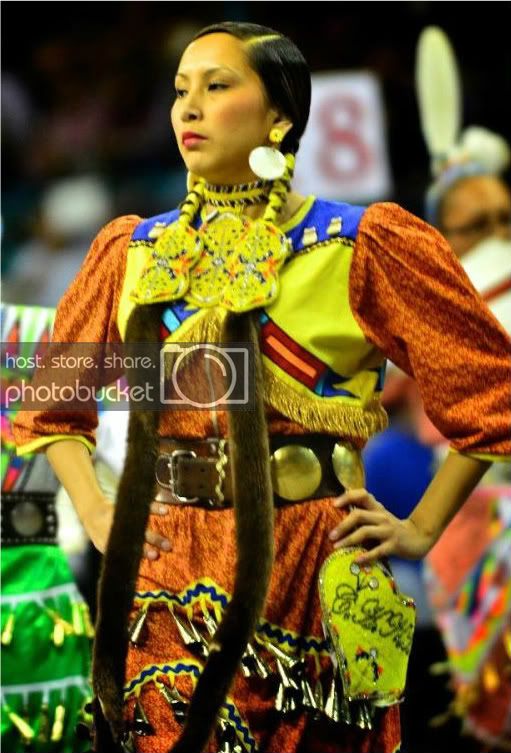
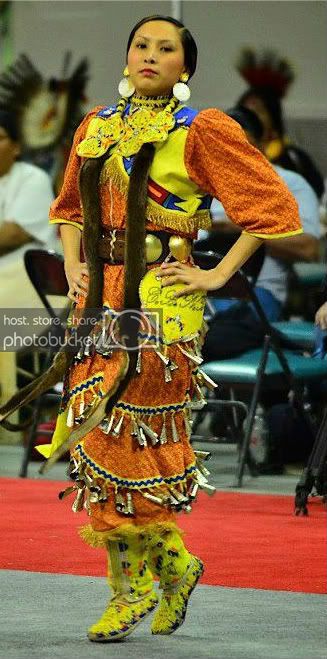
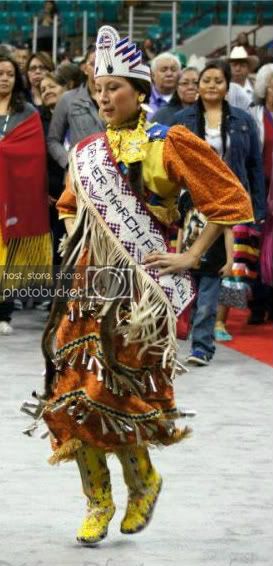
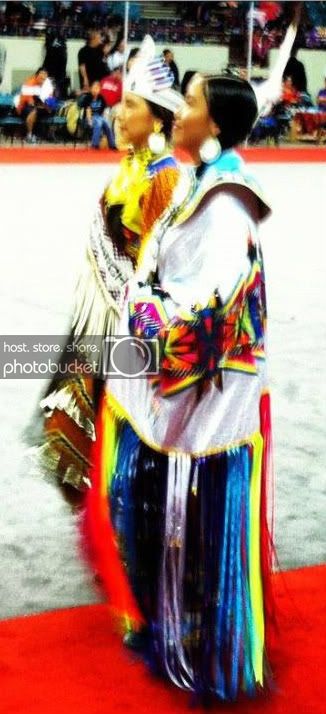
Powwows are one of our richest cultural community events. They take place all across the nation, and there is a powwow circuit that many dancers follow to compete for money rewards. Powwows are also spiritual events, a way to give thanks to the creator and pay tribute to our veterans. Like the Miss Navajo Nation contest, the powwow royalty competes based on skill. There is no, nor will there ever be, a bathing suit contest. If you haven’t attended a powwow, you should but be aware there are cultural rules you need to follow.
-navajo
• Lakota Hunger Strikers Target Enbridge Tar Sands Pipeline: The Lakota Hunger Strike for Sacred Water Protection began today at 11 a.m. and will continue through Tuesday, April 3. The strike is in solidarity with First Nations people of Canada who opposed a proposed pipeline that would run from Alberta to Pacific ports to supply supertankers with tar sands oil for shipping along the coast of the Great Bear Rainforest. In a statement, Cheyenne River Reservation participants said: “Mining corporations use and contaminate an enormous, irreplaceable amount of pure drinking water, creating the world’s greatest ecological manmade disaster in the extraction of tar-sands oil.” Strikers will burn a sacred fire at a campsite on the reservation near Eagle Butte for the entire 48 hours they go without eating.
-Meteor Blades
• Amnesty Int’l Reports on Abuses of Immigrants, Natives in Southwest: The 85-page report, titled “In Hostile Terrain: Human Rights Violations in Immigration Enforcement in the U.S. Southwest,” says there are systemic failures of federal, state and local authorities to enforce immigration laws without discrimination. “Communities living along the U.S.-Mexico border, particularly Latinos, individuals perceived to be of Latino origin and indigenous communities, are disproportionately affected by a range of immigration-control measures, resulting in a pattern of human rights violations.”
-Meteor Blades
• Meet the Vochol, Beadwork on Wheels:

smothering it in their characteristic beadwork. (Courtesy of Smithsonian Magazine.com via ICTMN)
At one time, hailing a cab Mexico City meant that about half the time you would be taken to your destination in a Volkswagen Beetle, the Bug in the United States, but the “Vocho” in Mexico. Indeed, the car was a favorite everywhere. I once rented a brand new one in Nogales, drove it all around Mexico for two weeks before dropping it off in Mérida. But I never saw one like this done up in the intricate style of the Huichol Indians of Nayarit and Jalisco. It’s the work of Huichols Francisco Bautista Carrillo and his daughter Kena Bautista, 227 million beads’ worth. The vehicle is named the Vochol, a combination of the nickname Vocho, and the tribal name Huichol.
-Meteor Blades
• Illinois Junior High School Votes to Drop Indian Mascot: Aptakisic Junior High in Buffalo Grove, named after the man who was chief of the area’s Potawatomi tribe nearly 200 years ago, recently announced it’s changing its sport mascot from the “Indians” to the “Eagles.” The principal noted that this generation of kids is very sensitive and more aware of the harmful effects of Native American mascots.
-navajo with a h/t to lexalou
• Indian Inmates Challenge S.D. Prison Tobacco Ban: In a federal trial of a lawsuit filed in 2009, a Lakota traditional healer, Richard Moves Camp (Oglala Lakota), has argued that tobacco is an integral part of American Indian religious ceremonies and denying its use can be compared with taking away the Bible from a Christian. South Dakota prisons ban even ceremonial tobacco use. Camp said tobacco has been a central part of prayer for thousands of years. Inmates Blaine Brings Plenty and Clayton Creek, both Oglala Lakotas and members of prison-based Native American Council of Tribes filed the suit.
-Meteor Blades
• Department of Labor Announces $60 Million in Indian Jobs & Training Grants: Via the Workforce Investment Act’s Section 166-Indian and Native American Programs (INAP), the grants are targeted to American Indian, Alaska Native and Native Hawaiian communities for developing academic, occupational, and literacy skills to individuals making more competitive in the workforce. The grants will be administered in accordance with the community’s goals and values. Of the total, $12.4 million of grants will be focused on youth programs.
-Meteor Blades
• ACLU Sues BIA-Run School for Publicly Humiliating Navajo Student for Pregnancy: Last fall, Shantelle Hicks (Navajo) was a 15-year-old student at Wingate Boarding School in Gallup, N.M., who was expelled for being pregnant. Advised that expulsion for pregnancy was discriminatory and a violation of state law, they re-admitted her, but not before forcibly mandating her attendance at an all-school assembly, where they brought her in front of the entire student body and publicly shamed her for having a pregnancy out of wedlock. At the time, only one other person knew of the pregnancy – her sister. Privately, the school told Hicks she was a bad example and should look for another school. On March 6, the ACLU filed a suit against the Bureau of Indian Education school, a teacher and a counselor “seeking punitive damages and declaratory relief for violation of constitutional rights to equal protection and of the Title IX prohibition against sex and pregnancy discrimination in education.” A KOB.com reporter telephoned the principal, Timothy Nelson, who said the allegations weren’t true and hung up.
-navajo with a h/t to Aji
• Standing Rock Sioux Chairman Keeps Position: Charlie Murphy (Dakota) has kept his post as chairman of the Standing Rock Sioux tribe whose reservation straddles North and South Dakota. Charges of misconduct and neglect of office were voted down 12-3 and 9-6 in the seven-hour meeting of the tribal council. All charges had to do with recent personnel moves that spurred tribal member Avis Little Eagle to seek Murphy’s removal. Little Eagle is a former managing editor of the on-line newspaper Indian Country Today. Murphy beat incumbent Ron His Horse Is Thunder in an election two years ago. One casualty of the effort to oust Murphy was executive director Cheryl Kary who had pushed through extensive changes in operations of the tribe’s executive branch.
-Meteor Blades
• Federal Judge Says No Taxing of Mashantucket’s Slot Machines: An attempt by the town of Ledyard, Conn., will not be able to collect property taxes on slot machines that the Mashantucket (Western) Pequot Tribal Nation leases from non-Indian vendors has run afoul of federal district Judge Warren W. Eginton. He agreed with the Mashantucket’s lawsuit saying the town’s action are pre-empted by the Indian Gaming Regulatory Act and violate the tribe’s sovereignty. Documents on the case can be found here.
-Meteor Blades
• AMC Developing Carlisle School Show: ‘The Real All Americans’: The channel is in the early stages of development for a show directed by Tommy Lee Jones (Cherokee) about the football team at the Carlisle Indian Industrial School that included famed Olympian Jim Thorpe. The exact parameters are not known but will certainly include some focus on Capt. Richard Henry Pratt, who founded the school to “civilize” Indians and made the notorious remark in an 1892 speech in Denver “that all the Indian there is in the race should be dead. Kill the Indian in him, and save the man.”
-Meteor Blades
Indians have often been referred to as the “Vanishing Americans.” But we are still here, entangled each in his or her unique way with modern America, blended into the dominant culture or not, full-blood or not, on the reservation or not, and living lives much like the lives of other Americans, but with differences related to our history on this continent, our diverse cultures and religions, and our special legal status. To most other Americans, we are invisible, or only perceived in the most stereotyped fashion.First Nations News & Views is designed to provide a window into our world, each Sunday reporting on a small number of stories, both the good and the not-so-good, and providing a reminder of where we came from, what we are doing now and what matters to us. We wish to make it clear that neither navajo nor I make any claim whatsoever to speak for anyone other than ourselves, as individuals, not for the Navajo people or the Seminole people, the tribes in which we are enrolled as members, nor, of course, the people of any other tribes.
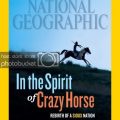
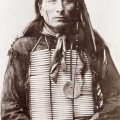
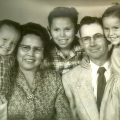

Leave a Reply